




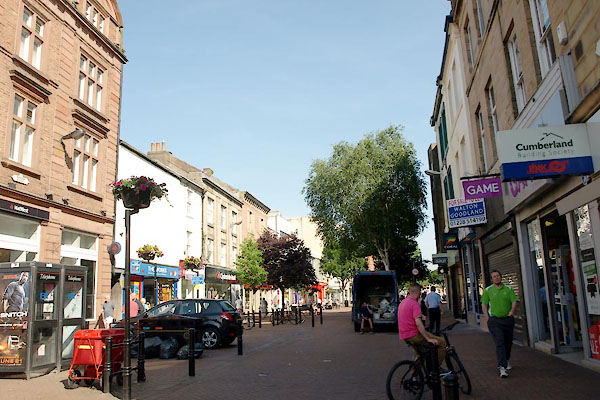
BYT24.jpg (taken 9.7.2013)
placename:- English Street
placename:- English Street
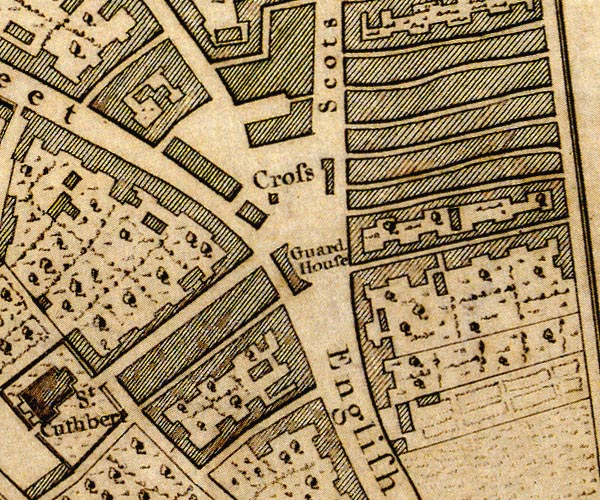
D44055E.jpg
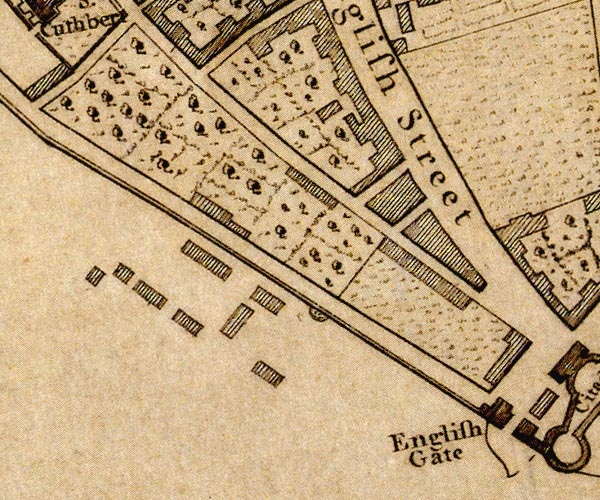
D44055D.jpg
"English Street"
street
item:- Carlisle Library : Map 2
Images © Carlisle Library
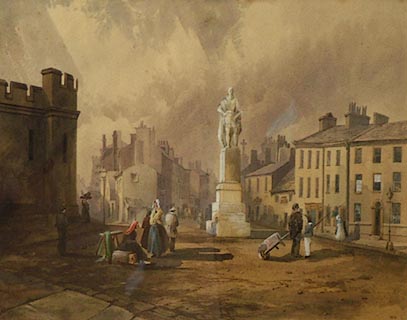 click to enlarge
click to enlargePR1151.jpg
Early morning street scene with tradespeople delivering their wares. In the foreground a woman sits with a basket of goods beside her; to left, a woman approaches with a tray of goods balanced on her head and to right a man with a barrow stands conversing to a boy wearing a sailor suit. The courthouses stand to left of composition, a distant view of the cathedral being glimpsed above the buildings of the town. In the centre stands an imposing statue.
signed &dated at bottom right:- "JB Smith 1847"
item:- Tullie House Museum : 1974.42.2
Image © Tullie House Museum
item:- Carlisle Journal
 goto source
goto sourceGentleman's Magazine 1860 part 1 p.348 "..."
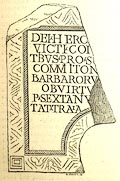 click to enlarge
click to enlargeG860E01.jpg
"A second, but smaller stone, found near the former, furnished the subject of another paper by Dr. Bruce. We are indebted to the courtesy of P. H. Howard, Esq., of Corby, and John Gough Nichols, Esq., for the accompanying accurate representation of the slab."
"Dr. Bruce exhibited drawings of Roman and Ancient British Remains, sent to him by Mr. Mackie of Carlisle, and then said:-"
""At our last monthly meeting, I had the pleasure of laying before the members an interesting fragment of an important Roman inscription discovered at Carlisle. Since that period another inscribed stone has been exhumed on the same spot - (the site where the buildings for the new offices of the 'Carlisle Journal' are"
item:- roman inscription; inscription, roman
 goto source
goto sourceGentleman's Magazine 1860 part 1 p.349 "being erected). As usual, the stone is fractured. In the last example we had the lower lines of the inscription complete. In this case, the fracture is vertical, and the right hand portion of the stone is altogether wanting. Hence, though we have a portion of every line of the inscription, we have not one copmplete. In all probablity, the present fragment is only half of the original. When whole, it has, seemingly, been a square tablet, with a circular recess at the bottom. It may have been placed over a statue, the head of which occupied the recess. The stone, as we now have it, is 1 ft. 11 in. long, 1 ft. 3 in. broad, and 4 in. thick. The sides are panelled. The margin of the face of the tablet is tastefully adorned by a moulding of the cable pattern. The letters of the inscription are very clearly cut, and possess a beauty of form well worty the attention of modern type-founders. The following is the inscription:-"
"DEI HERC ...
VICTI COI ...
TrBVS PRO S ...
COMMiLiTON ...
BARBARORV ...
OB VIRTV ...
P SEXTANiV ...
TAT TRAIA ..."
"Some ligatures (or tied letters) are introduced in the inscription, but they are of a very simple description. They are indicated in the foregoing copy by a smaller type. Judging from the character of the letters and the simplicity of the ligatures, the inscription is probably not later than the time of Heliogabalus. The inscription is quite new in its character; and hence, if complete, would probably present some fresh phase of society in Roman Britain. Judging from the portion of the circular recess at the bottom which is deficient, we have as yet got only half of the inscription. It is a hazardous, and, for historical purposes, an unsatisfactory thing in such circumstances, to draw upon the imagination for the remainder. The stone was probably set up in a temple of Hercules, who, among his other titles, reckoned those of Invictus and Conservator, traces of which appear in the inscription. One peculiarity of the stone is that the name of the deity is in the genitive case. The word governing it is wanting, so that we do not know the precise form of dedication. Perhaps the word numini (to the majesty of the god) is to be supplied; or perhaps the dedication is to some fellowship of the priests or worshippers of the god - Sodalicio cultorum Herculis; or it may be that the word fanum is on the missing part of the stone; in which case the first lines of the inscription would simply announce the fact that this was a temple of Hercules. Our chairman, Mr. Clayton, informs me that he saw at Verona a slab containing the words Fanum Herculis. This slab, or the statute which probably accompanied it, had evidently been set up 'for the safety' (pro salute) of some individual or body of men. If we take the words as they stand before us, they read, 'for the safety of our foreign fellow-soldiers, on account of their valour.' In this case the inscription has been made by Italian troops, in honour of some auxiliary cohort or ala with whom they had co-operated. This interpretation breathes a more kindly feeling than we should expect from Latin soldiers. The word barbarus, as applied to foreign troops, is exceedingly rare in Roman inscriptions, if, indeed, another example besides this can be found. It is not impossible that, should the remainder of the inscription turn up, the occasion of its erection may prove to have been a successful onslaught of the"
 goto source
goto sourceGentleman's Magazine 1860 part 1 p.350 "Romans on the barbarians of Caledonia. It will be in the recollection of most of us, that at Kirkandrews, a village to the west of Carlisle, there is an altar which has been erected to some deity whose name is lost - ob res trans vallum prospere gestas - on account of achievements prosperously performed beyond the Wall. Of the remainder of the Carlisle inscription little is certain, excepting that one Publius Sextanius, or Sextantius, seems to have some hand in it. This is not a name known in Roman story. The discovery of another inscription, so soon after the one described at our last meeting shews how rich the site of Carlisle is in historic relics of the Roman era. Should any event, toward or untoward, require the rebuilding of the present city, a mass of historic lore would probably be disinterred which in real value would amply repay the cost of the operation.""
"Though, as we have said, these inscriptions are so imperfect, and therefore leave a wide field for conjecture, we can hardly doubt but that Dr. Bruce or some other of our Roman antiquaries will eventually succeed in satisfactorily determining their meaning. The discovery of two inscriptions so near to each other raises a presumption that the soil of Carlisle must be rich in such remains, and if so, it will contrast strongly with other Roman sites that have been recently explored. The great excavations at Chesterford did not produce a single inscription, and little more can be said of those at Uriconium, though most interesting and important in their revelation of other matters."
"..."
item:- roman inscription; inscription, roman; Carlisle Journal
 goto source
goto sourceGentleman's Magazine 1860 part 1 p.346 "ROMAN INSCRIPTIONS DISCOVERED AT CARLISLE."
"Two remarkable inscribed slabs have recently been found in excavating a foundation for the new office of the "Journal," in English-street, Carlisle. Unfortunately they are both imperfect, and the purport if their inscriptions is therefore doubtful. Dr. Collingwood Bruce, the historian of the Roman Wall, has, however, suggested explanations, in papers read before the Society of Antiquaries, Newcastle-on-Tyne, in February and March last. The following are his remarks on the slab first discovered:-"
"The slab is of a large size, 5 feet 3 inches long and a foot thick. Unfortunately the upper portion is gone. The stone has suffered from that vengeance, on the part of the Caledonians, on the occasion of a successful onslaught, which so many of the relics of Rome in these parts bear marks of. That part of the inscription, which no doubt told of the occasion of its being cut, is lost; but there can be little doubt that it was to commemorate the erection of some building of importance, probably a temple. The names of the chief officials engaged in the work are also lost, with the exception of the fragments of four letters. Notwithstanding these ravages, the stone is of great value, and that part of the inscription that is left gives us information which we did not possess before."
"The inscription may, I think, be thus read:-"
"... ... ... ...
... ... LVCA[NVS]
PRAEF[ECTVS] ALAE AVGVSTAE
PETRIANAE TORQ[VATAE] M[ILLIARIAE] C[IVIVM] R[OMANORVM]
D[E]D[ICAVERVNT] (or D[E]D[ICAVIT])."
"'(This temple) was dedicated to --, by Lucanus (?) the Prefect of the Petriana Cavalry, surnamed Augustan, entitled to wear the torque, consisting of a thousand men, all Roman citizens.'"
"The notices which we have previously had of the Ala Petriana have been very scanty. Its name appears on the Riveling rescript, along with other troops then in Britain, under the charge of Aulus Platorius Nepos. This rescript belongs to the eighth tribuneship of Hadrian, answering to A.D. 124."
"..."
item:- Carlisle Journal; roman inscription; inscription, roman; roman altar
 goto source
goto sourceGentleman's Magazine 1861 part 2 p.529
Society of Antiquaries, Newcastle-upon-Tyne:- "Dr. Bruce, F.S.A., gave some information and exhibited sketches obtained from Mr. Henry T. Wake, of Scotby, of some Roman remains discovered in May last, on the site of Mr. Thomas Blair's house, near the "Journal" Office, in English-street, Carlisle, in rebuilding which office, it will be remembered, former discoveries took placea. There are three inscribed stones. One, with a sunk square at the top, evidently for the reception of statues of the goddess mothers, The Fates, is inscribed -"
"MATRIB. PARC PRO SALVT
SANCTIAE. GEMINAE."
"Another, a votive altar with the name IANVARIVS amongst other lettering, is very mutilated. The third, though mutilated, has a perfect inscription :-"
"PARCIS
PROBO
DONATALIS
PATER. V. S.
L. M."
"The coins found were corroded and unim-"
"a GENT. MAG., April, 1860, p.346."
item:- roman finds
 goto source
goto sourceGentleman's Magazine 1861 part 2 p.530 "[unim]portant. One seemed to be a small brass of the Lower Empire. Among other fragments of Samian there was one stamped AEMILIANVS. Some large oak cisterns, puddled with clay brought from a distance, were also found. The first two were supposed to be coffins, but a third proved to be six feet square. Their boards were about 13/4in. thick, and were fastened tgether with wooden pegs."
"In the same street some other relics of Roman dominion had also been found not long before. There was a little glass lachrymotary entire, and many fragments of Samian and other pottery, among them the following:- a mortarium, with the spout; a large piece, stamped in two places with AVSTIMANV; a Samina mortarium with a hole through it, and a lion's mouth through which the liquid ran; a piece of vessel made of a dark slate-coloured material, glazed, very hard and thin, slightly ornamented with diagonal dashes placed close together, and, to Mr. Wake's eye, of finer pottery than the best Samian ware that he had seen."
"..."
